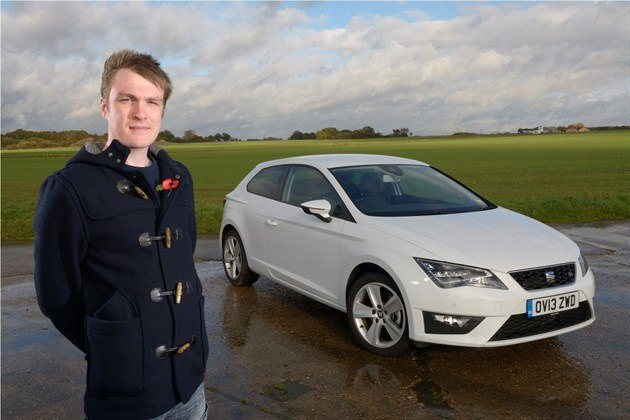SEAT Leon SC FR 1.4 TSI
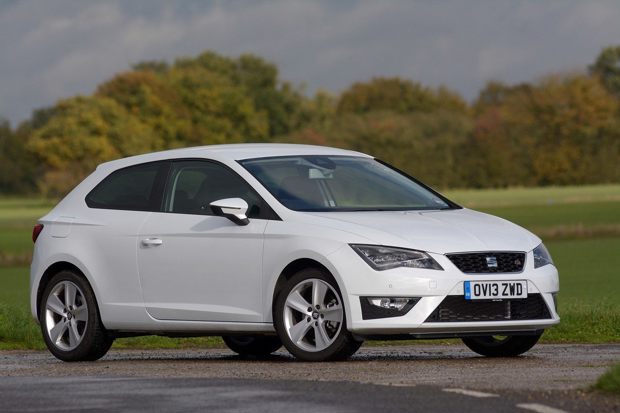

- Advanced technology in our new Leon
- The history of the SEAT Leon
- Platform Partners
- We have a problem…
- How about something completely different?
- Coping with the weather
- Christmas miles in the Leon
- Maximising fuel economy
- All aboard
- Are you not infotained?
- Out of semi-retirement
- We wave goodbye to the Leon
Advanced technology in our new Leon
We welcome the Seat Leon SC FR to Our Cars, and it’s loaded with some of the most desirable technology on offer.

Date: 10 October 2013 | Current mileage: 890 | Claimed economy: 54.3mpg | Actual economy: 44.3mpg
Say hello to the SEAT Leon SC FR 1.4 TSI. It's a car we've been looking forward to having on the Our Cars fleet, even if it does have a rather long-winded name. The three-door version of the new Leon certainly looks the part in the optional metallic white paint – but what really makes it stand out is the all-LED headlights.
They’re part of a range of technology on the new SEAT that makes me really excited about spending six months with it – it comes with DAB radio and a really nifty touchscreen infotainment system, automatically dipping headlights, automatic wipers and a lane assistance function that steers the car to help keep it from straying off course.
The engine is pretty high tech too – it might only be a 1.4-litre but it has a turbocharger to boost power to 140PS. Add to that a peak torque figure of 250Nm and you get a pretty speedy recipe – 0-62mph takes 8.2 seconds and top speed is 131mph, but with emissions of 119g/km and economy of 54.3mpg. You wouldn’t be saying that about a 1.4 a few years go.
The full specification for our Leon includes £930 of options which isn’t too unreasonable. That includes the £475 metallic paint and four equipment packs – a £100 convenience pack of rain sensing wipers, light sensor and auto dimming rear view mirror; a £295 driver assist pack of high beam assist and lane keep assist; a £60 LED interior lighting pack and a technology pack with LED headlights, a navigation system and DAB radio which was a free offer when our car was ordered.
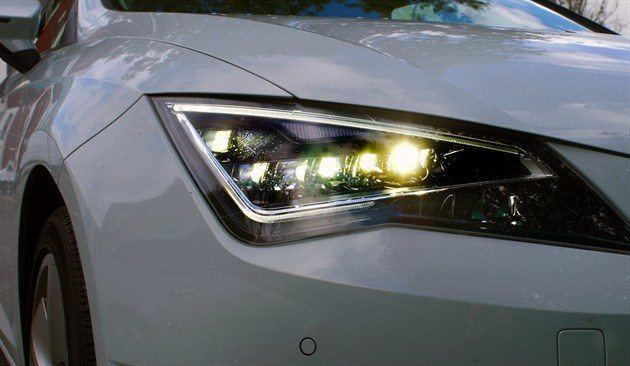
No bulbs here - our Leon has all-LED headlights
One thing that I really appreciate already is the fact my iPad will sync up to the touchscreen system in the Leon – it flat refused in my previous Hyundai i30. That’s good for me because I keep all of my music on my iPad and I don’t want to buy a smaller iPod just so I can listen in the car.
It’ll be interesting to see how some of the technology works in day to day situations – the all-LED headlights look great but will they provide as much illumination as a more traditional bulb? And can you really trust a sensor to dip the headlights when encountering a car on a dark country lane?
The FR trim comes with some pretty nice styling details – there are sporty seats, FR badges inside and out, red stitching, a leather trimmed wheel, cruise control and FR styling outside giving it a hot-hatch look. Until the Cupra arrives next year, this is the sportiest looking Leon you can get.
Unfortunately, while the white paint really looks fantastic, it shows dirt within a day of being washed, particularly in smoggy London. That’s exacerbated by a pesky cat which will always stand on the bonnet and cover it in wet, muddy paw prints. Rather amusingly said cat will often slip off the bonnet if it stands too near the front – perhaps that’s aerodynamics...
So far I’ve covered a few hundred miles and based on first impressions the Leon is a pretty comprehensive package – it feels solid and well put together, it’s not massively expensive considering the level of equipment and it’s great fun to drive. On paper it should be cheap to run too, but it remains to be seen how good the fuel economy – and everything else - will be in the long term.
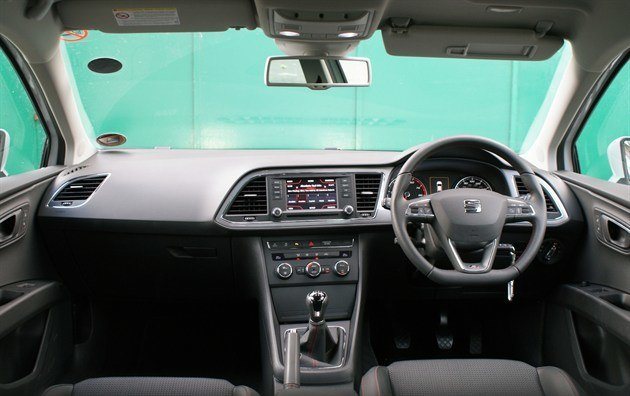
Sleek interior has a real quality feel
The history of the SEAT Leon
The new Leon is undoubtedly capable but SEAT wasn't always such a strong brand. Time to chart the history of our Leon's predecessors.
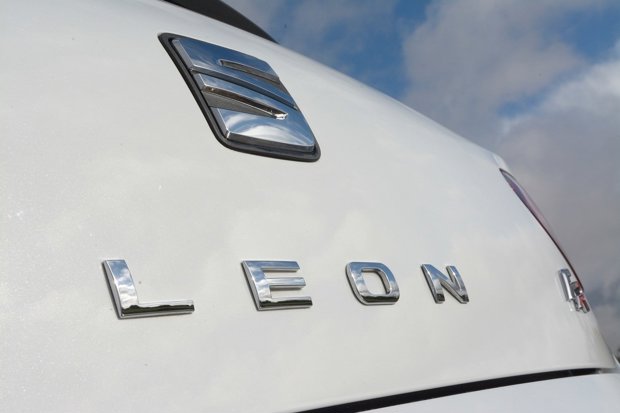
Date: 28 October 2013 | Current mileage: 1133 | Claimed economy: 54.3mpg | Actual economy: 44.3mpg
Sociedad Española de Automóviles de Turismo (SEAT), or the Spanish Touring Car Company was founded in 1950 in alliance with Fiat. It took a few years for SEAT to produce its first car, the 1400, which was really a Fiat 1400 produced under licence, wearing SEAT badges. SEAT continued to produce licence-built Fiats until the early 1980s when a dispute over funding erupted between the two brands.
Eventually the dispute meant that SEAT needed salvation and that came from Volkswagen in the mid-1980s. Gradually Volkswagen Group bought further interests in the brand until it became a wholly owned subsidiary – effectively the SEAT we know today. That patchy history means the current generation Leon has lots of ancestors - in this update I’m counting down through some of the most important.
SEAT 1400

The 1400 was where it all began for SEAT - it was the maker's very first car. Produced from 1953-1963 it was a licence built Fiat 1400, so while it might be an important car in SEAT's history it's hardly particularly noteworthy. Power came from a 1400cc engine, hence the name, and claimed power was around 44PS. Not exactly electrifying!
SEAT 1430
The 1430 is arguably the originator of the Leon. Back in 1969 when it was introduced the average family car was a saloon, rather than a hatchback, but the lineage can be traced back to the 124, another Fiat design built under licence. SEAT's modern, sporty image can be traced back to the 'Especial' variant of this car, too.
SEAT 131

The 131 was not radically different from the 1430 it succeeded, with the same three-box styling. It was based on the Fiat 131, but with adaptions for the Spanish market. Later in its life the 131 was sold with a diesel engine with a rather large 2.5-litre capacity.
SEAT Ronda

The Ronda was SEAT's first self-developed car, although Fiat argued that it was a replica of the Ritmo. Indeed the two brands fell out sufficiently for the case to go to court where the judge decided the Ronda was different from the Ritmo and that it wasn't a copy after all.
SEAT Malaga

Being a family saloon car, the Malaga was a successor to the 131 but it's really a mishmash. Chop the boot off and its a saloon version of the Ibiza, which itself is based on the Ronda. It's the last car in this list that is related to Fiat - Volkswagen Group took the reigns before the Toledo was produced.
SEAT Toledo

The first generation Toledo is built on the Golf Mk2 platform, much like the current Leon is based on the same platform as the Golf Mk7. It wasn't a massive seller and perhaps its biggest claim to fame is the fact it was the star prize on Family Fortunes quite regularly through the 1990s.
Leon I

With the first generation Leon, SEAT broadened its range. Built on the Golf Mk4 platform it managed to deliver excitement, with bright colours and sporty engines on offer. The Toledo continued in production as a saloon variant of this generation Leon, too.
Leon II

The second generation Leon continued with the youthful image of its predecessor. Most exciting of the lot was the Cupra R, a 265PS hot hatch that really gave the SEAT brand an image boost. For this generation the separation between the Toledo and Leon grew further, with the former becoming a sort of mini-MPV.
Leon III

The success of the Leon meant a pre-existing customer base for the latest generation Leon. It's not quite as radically styled as its predecessor, but it is packed with technology and offers good value for money. That ought to make it popular with owners upgrading from the old car. But does it have the same sporty character and will it be as easy to live with? We'll find out in the coming months.
Platform Partners
The SEAT Leon is built on Volkswagen-Audi group's MQB platform - so what else shares its underpinnings?

Date: 11 November 2013 | Current mileage: 1462 | Claimed economy: 54.3mpg | Actual economy: 43.3mpg
It’s no secret that SEAT is part of the Volkswagen Group, which encompasses a huge number of well-respected car makers – Volkswagen, of course, along with Audi, Skoda, Porsche, Lamborgini and even Bugatti. It’s quite logical, then, that the group should share resources across brands. Underneath the SEAT badging my Leon shares a lot with a few other cars from Volkswagen Group, including its platform and engines.
The platform itself is called MQB – which isn’t exactly inspiring. It means Modularer Querbaukasten which is German for something even less interesting, but the important point is that it’s the very floor of the car, and it’s a component shared between the latest Volkswagen Golf, SEAT Leon, Skoda Octavia and Audi A3. It’s likely to be used in some upcoming cars too including the next generation Audi TT – so it’s a versatile piece of kit.
It means, in theory, that engines and drivetrains can be fitted across the board – in theory there could be an all-wheel drive version of the Leon powered by the same engine as an Audi S3. Whether that will happen or not is a different matter of course, because efforts have been made to imbue each brand with its own sense of identity.
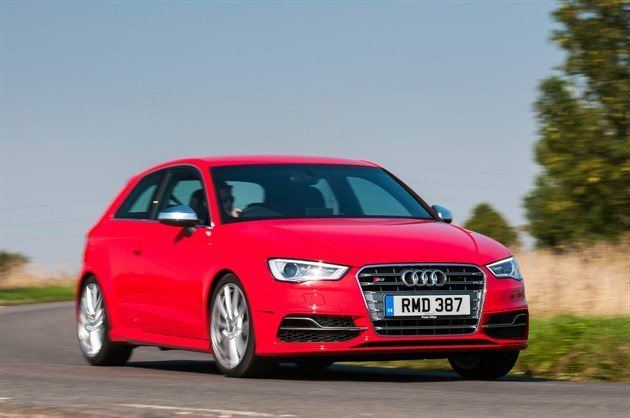
In theory the Leon could be fitted with all-wheel drive
Audi is all about prestige and quality, SEAT stands for youthful dynamism and Skoda represents value and sensibility. Strangely that leaves Volkswagen to occupy a no-man’s land between the three, but arguably it doesn’t need a special 'identity' because it relies on its reputation, which goes back further than that of any other Volkwagen Group brand.
One of the worries about sharing bits and pieces across various models of car is that it will lead to compromise, which will lead to a less polished product. Thankfully that’s not the case with any of the current four MQB platform cars – in fact it means quite the opposite. The Skoda, Volkswagen, Audi and SEAT are all very accomplished and impressive cars.
What it does provide is choice – buyers looking for a good quality, solid family car would do well to consider any of the four cars. So why pick the SEAT over the more prestigious Audi or Volkswagen? Well there’s price, for a start. The Leon is priced from £15,550 while the Golf starts at £16,495. The A3 is even pricier at £18,900, while the Octavia from Skoda is £15,990.
That means the sportiest and most youthful looking of the bunch is the cheapest and most accessible, while the most spacious and practical offers the best value for money and the most prestigious commands the highest premium. Which leaves the Golf somewhere in the middle – but that doesn’t seem to stop it from selling. Looks like the bean counters in Germany thought it through…
We have a problem…
Lane keep assist and high beam assist are great gadgets to have – but the system on our Leon malfunctioned.
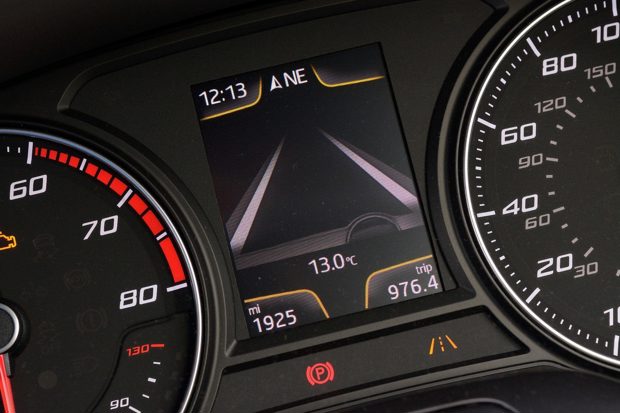
Date: 21 November 2013 | Current mileage: 1393 | Claimed economy: 54.3mpg | Actual economy: 43.4mpg
Car manufacturers are putting more and more technology into modern cars. With full-LED lights, high beam assist and lane keep assist my SEAT Leon is no exception. I had experienced the lane keep assistance system on a couple of cars before so I knew what to expect, but found it to be slightly troublesome.
In normal operation the lane assist detects the white lines marking each lane and will ‘nudge’ the steering to keep the car in the centre of its lane. It assists you, rather than taking over and in practice it’s a useful system because it keeps you from straying into another lane when checking the nav screen or setting the climate control.
The instrument binnacle has a little screen in it which can be set to show the status of the lane assist – it shows which lines the system can see and shows whether the system is active or not. When the car arrived the readout would often detect one line, or would work for a few seconds and then stop.
Initially I thought it might be down to the weather conditions or the lighting so I ignored it, until one wet, grey day it started to work perfectly. But it didn’t last long – and the system eventually gave up completely, informing me that there was a ‘fault.’ I tried cleaning the screen in front of the sensor, but to no avail. So back to SEAT.
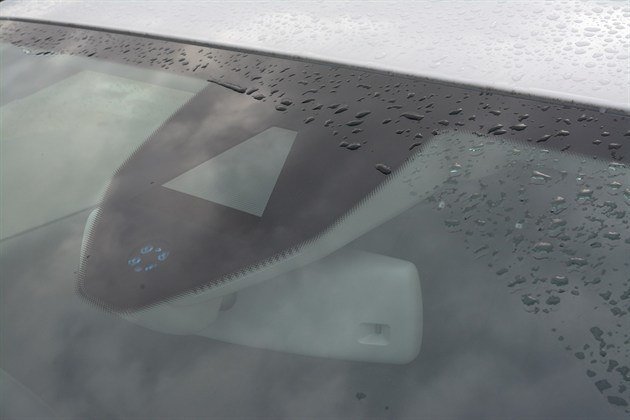
The sensor, hidden above the mirror, was misaligned. It was a quick fix.
Thankfully the problem was nothing more than the sensor having managed to work its way loose. A final jolt - perhaps a speed bump or pothole – caused it to misalign entirely. It was tightened up and it fixed the problem completely. It’s still a bit disappointing that it wasn’t perfect in the first place of course.
Incidentally the high beam assist wasn’t as problematic as the lane assist, despite using the same sensor. At first it was fine but it did deteriorate over time until giving up entirely when the ‘fault’ message appeared. It’s working fine again now the sensor has been realigned.
The problem hasn’t been a major inconvenience – the car drove just the same without the systems working and neither of them is incredibly important, but it does go to show that adding extra technology to cars adds extra potential problem areas. The issue doesn’t seem to be widespread, though – we’ve had no reports of anything similar in any Volkswagen group vehicles.
How about something completely different?
For new car buyers there's never been such a variety of cars to choose from - so aside from a hatch what else can you get for £20,000?

Date: 5 December 2013 | Current mileage: 1495 | Claimed economy: 54.3mpg | Actual economy: 43.2mpg
When buying a new car there’s more variety now than there ever has been. Buyers aren’t restricted to a saloons, hatchbacks or estates any more, there are tiny city cars, compact crossovers, MPVs and SUVs to muddy the waters. Add to that a breadth of trim levels and options and it’s tricky to decide what is within your budget and what is best for your needs.
Take my SEAT Leon. Its new price including a few optional extras is £20,015 – a price competitive with most family sized hatchbacks including the Ford Focus, Vauxhall Astra and Volkswagen Golf. It’s not that simple, though – for that much you could buy a mid-spec Toyota Verso MPV, or a sporty two-seater in the form of the MX-5 Roadster Coupe.
Narrowing the brief to be more specific doesn’t help too much either – I like an attractive car with a reasonable amount of space and affordable running costs but that’s fun to drive and works as an all-rounder in town or on the motorway. I typically only need two doors, but a back row of seats is handy for the few times I need to carry a third passenger.
So I decided to see if the my Leon is a good buy at £20,015 compared with something else I’d also considered at about the same price – the Nissan Juke Nismo. It’s the top model in the Juke range and with a 200PS 1.6-litre engine it’s got more power than our Leon, with the advantage of a high driving position and two more doors, but it’s about the same price at £20,395.
It makes a good first impression. The Nismo version has an aggressive body kit that makes it look more purposeful than a lesser Juke and the pearl white paint finish is much nicer than that on the Leon, which looks a little flat in comparison. The Juke’s cabin impresses too, with Alcantara upholstery and sporty bucket seats.
Delving a little deeper does reveal some disappointing material choices though, with hard dashboard coverings and a few cheap-looking switches here and there – the Leon has much nicer soft-touch materials and the minor controls – like buttons and switches – feel more well engineered than they do in the Juke.
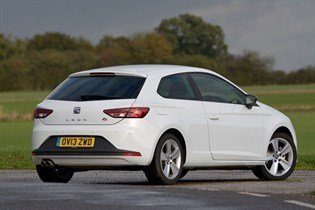
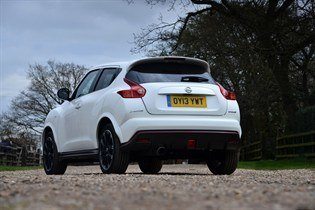
Similar price, different character
My Leon has a 1.4-litre petrol engine producing 140PS – a fair chunk less than the 200PS kicked out by the Juke Nismo’s 1.6-litre engine. Strangely enough though, the difference isn’t as striking as you’d expect. The Leon is sprightly enough to be entertaining and the Juke, thanks to noticeable turbo lag, can sometimes feel a bit slow, building its speed gradually as the turbo spools up.
That’s not really fair on the Juke because if you keep the needle in the right bit of the rev counter and work the gearbox it’s great fun – and on a twisting country road it offers exciting handling, with accurate steering and little body roll despite the higher ride height. I'd say it’s more entertaining than the Leon.
The trade off is a very firm ride and compromises in other areas. Motorway cruising in the Juke isn’t enjoyable because the engine drones at 70mph and fuel economy isn’t very impressive – I averaged about 32mpg over a few hundred miles. Add to that a tiny fuel tank and visits to the pumps are all too frequent.
The two cars are fairly similar in terms of practicality. The boot in the Juke isn’t quite as good as the Leon, but the rear seats offer more room to balance things out. There’s less in the way of fancy technology in the Juke with no lane assist or full-LED headlights.
It’s not a big deal though. That kind of technology is like a garnish on a plate – it looks nice but it’s not that important. Still, picking between the two cars is fairly easy for me. The Leon is a better all-rounder which is easier to live with in town and on the motorway than the Juke Nismo. Since I spend almost all of my time in one of those environments it’s the smart choice.
However if I still lived in rural Yorkshire and I had mile-upon-mile of twisting country road, the answer would be different. The Juke Nismo is enormous fun, so if you’re not a regular motorway user and if you can cope with lots of trips to the petrol station it’s a great – if completely different – alternative to the Leon.
Coping with the weather
The SEAT Leon has coped well with the recent wet, grey and miserable weather, it's just a shame its white paint shows dirt so much.
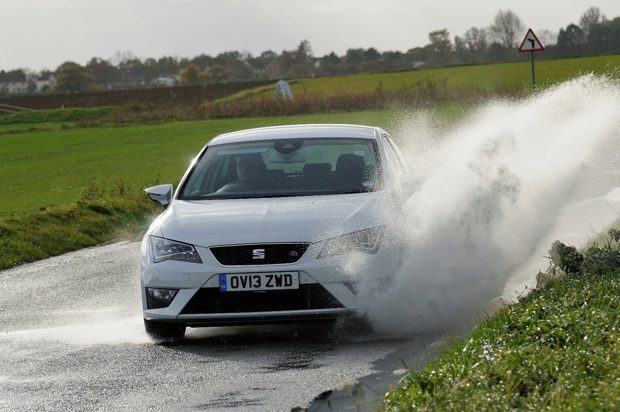
Date: 12 December 2013 | Current mileage: 1836 | Claimed economy: 54.3mpg | Actual economy: 43.2mpg
Winter usually means snow, but so far it’s just been wet. Very wet. That’s meant mile after mile of driving through downpours, floods and the resulting traffic jams, but thankfully the Leon has been pretty good despite all that Mother Nature has thrown at it, thanks in no small part to the technology on board.
Most importantly, in dim, damp weather is the convenience pack, which costs £100. It adds automatic headlights, an auto-dimming rear view mirror and automatic wipers. Auto-on lights are great when you live in town, because when it’s dull or even dark it’s easy to forget to turn them on yourself, thanks to an abundance of street lights.
They work flawlessly, activating in dull conditions and staying on, rather than turning themselves on and off over and over when the light changes. The same can’t be said for the automatic wipers though, which seem a little confused. Sometimes they’ll react properly to the weather and other times I’ll have to take control of them myself.
In fact I was so bothered I had to check the car even had them – I was starting to question whether or not I was imagining their reaction to the weather. Having said that I relentlessly fiddle with the indicator stalk to try and get exactly the right reaction from the wipers so it might be my fault that they don’t do precisely what I want them to.
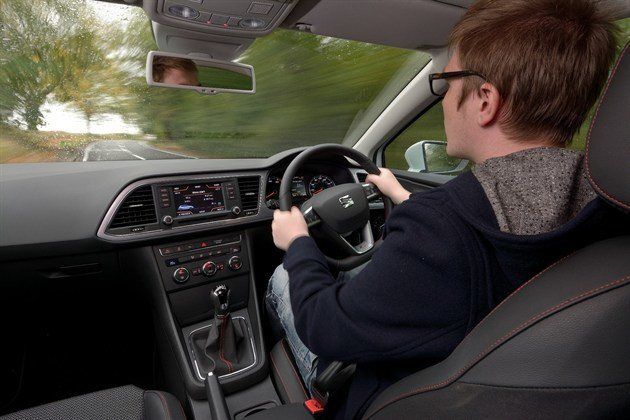
No heated seats, but the cabin warms up pretty quickly anyway.
The biggest issue of all so far in this bad weather has been the car’s colour. White shows even the tiniest bit of dirt, and because the weather never seems to improve it's a waste of money or effort to wash the car, because it’d be filthy again in five minutes, probably before I even got it home.
Aside from that the Leon has been a perfectly decent winter car. The air conditioning does a good job of quickly clearing condensation and the heater warms up quickly. SEAT does offer a winter pack, which I didn’t choose. It adds heated washer jets, which would be handy if I lived in a colder area, but they’re not needed in balmy London.
I do regret not specifying the winter pack’s heated front seats sometimes, though not as often as you might expect. That’s because when I do drive a car with them they ‘mysteriously’ turn on all by themselves when my partner is in the passenger seat. It was funny the first 200 times, but it’s wearing thin now.
I've not mentioned winter tyres yet and that's down to the fact I don't have them. Living in London means it's very rarely snowy. Winter tyres do help out in all temperatures below seven Celsius but in Richmond-upon-Thames and Shepherd's bush the roads are so busy any advantage of using winter tyres would be minimal.
I do travel out of London quite regularly of course, but usually it's on a major motorway so the surface will be well gritted and cleared of the worst snow or ice. Consequently there'd be little point in fitting a set of winter tyres. It'd be a different story if I lived out in the countryside, of course, where I would fit them without hesitation, much like David has with his Lexus.
Christmas miles in the Leon
A hectic Christmas break meant covering more than 700 miles in two days - but the SEAT coped well.
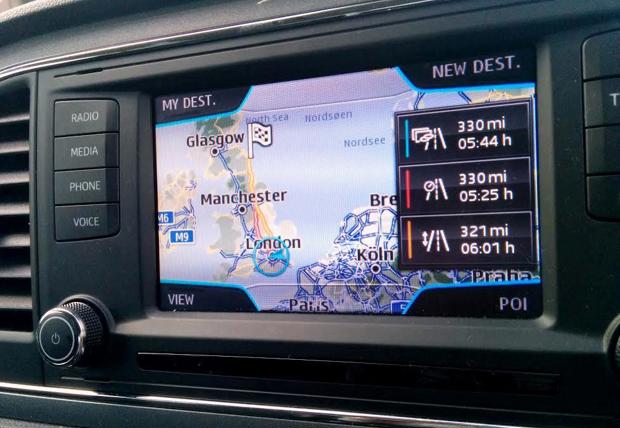
Date: 13 January 2014 | Current mileage: 2686 | Claimed economy: 54.3mpg | Actual economy: 43.2mpg
Christmas is always a highlight of the year, but having been brought up in the north it means I have to cover a long distance to see family, since I now live in London. In previous years that hasn’t been a major problem because the return journey would be after new year, with plenty of time to wind down and relax.
This year things were different. My partner’s family were staying in Northumberland, my family is in Yorkshire and my partner only had two days off. So we had to cram all our present opening, Christmas dinners and 700 miles of driving into two days.
Originally the plan was to leave at around 3am on Christmas Eve morning but instead we left at 6am. The roads were pretty much clear, so the cruise control and lane keep assist could get on with their jobs – and they made the first 200 miles utterly painless.
The car kept itself in its lane and maintained its speed, but you can't just have a nap - if the car thinks you've stopped steering then it'll warn you to take control again. Similarly, the Leon has old fashioned cruise control rather than a fancy adaptive system, so if you don't pay attention it'll drive you into the back of a truck.
We could easily switch between music en route – the Leon linked our iPod through a cable, which was supplied with the car, while my iPad linked up via Bluetooth. DAB reception was pretty good all the way up the M1, so the drive was easy and supplemented with a good selection of music.
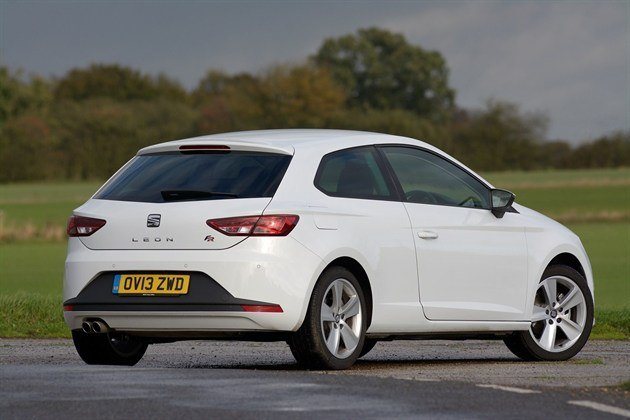
Unfortunately the sat nav had a hiccup near Nottingham. Having detected a traffic jam a few miles ahead it directed us off the M1 and towards the A1, via A-roads. I trusted it and started on the detour, only for it to refresh when I was halfway to the A1 and send me back to the M1.
Thankfully from there on out it was plain sailing. On Christmas morning we set out on a two hour trip to see my family and after a hearty meal it was back to London – another four hours. With a 1.4-litre petrol engine you might expect such a lot of driving to result in a headache, care of droning engine noise.
Not so with the SEAT, though. It might have a fairly small engine but thanks to its turbocharger there’s 140PS on tap and plenty of torque. Add in a sixth gear and the result is a surprisingly competent and impressively refined motorway cruiser – one that’d give most diesel-powered cars a run for their money.
So despite covering the same kind of mileage as a truck does in two days I never felt too uncomfortable and I arrived at the end of both trips feeling fairly supple and awake. Fuel economy wasn’t too bad either – at a steady cruise I was getting close to 50mpg – it’d have been better if the car didn’t have a fully loaded boot and a passenger.
Maximising fuel economy
How close does the Leon get to its official fuel consumption figure - and how much is that dependent on driving style?
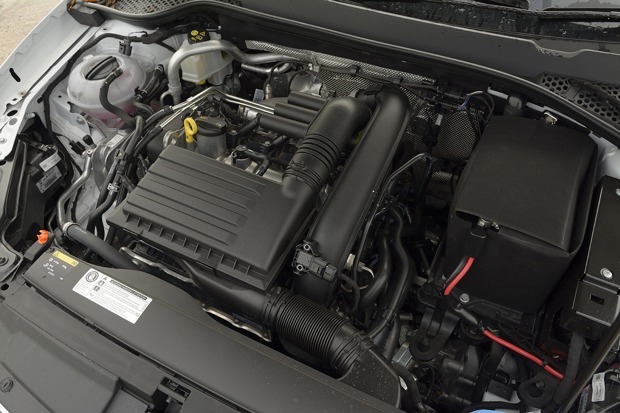
Date: 27 January 2014 | Current mileage 2912 | Claimed economy 54.3mpg | Actual economy 47.6mpg
I took my brother out in the Leon the other day for the first time, without telling him what engine is under the bonnet. After a blast up the motorway slip road I asked him what kind of engine he thought it had. Bearing in mind he drives a 2.5-litre V6 Mondeo, he reckoned it was a 2.0-litre petrol.
So he was quite surprised when I told him it was a mere 1.4-litre. His guess was pretty well educated, after all – ten years ago a car with 140PS would almost certainly be a 2.0-litre – or maybe a 1.8-litre at a push. Nowadays things are different – there’s a drive to downsize with smaller, turbocharged engines.
The supposed advantage is an improvement in fuel economy, but with no performance losses. In fact, the turbocharger in our Leon gives better performance than a normally aspirated 2.0-litre thanks to its easily accessible torque, low down the rev range. It’s also pretty frugal compared to an older 2.0-litre engine - that's progress.
However it isn’t as frugal as the official figures would suggest. The combined cycle test produced an official 54.3mpg but in reality I’m getting nearer 43mpg. A quick check in the Real MPG section shows that other owners are doing better though, managing 46.1mpg on average – 15% short of the official figure. That’s pretty typical across all makes and models.
Interestingly SEAT has installed a system in the Leon to help improve fuel economy as much as is possible – not by altering any aspect of the car directly, but by coaching the driver into a more economical driving style. Little ‘Eco-tip’ messages appear in the dashboard to tell you to change up a gear, or to avoid depressing the clutch when the revs are above 1300rpm.
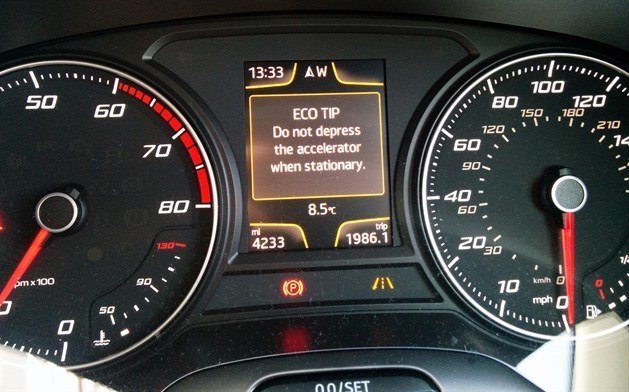
There's a lot of these messages...
Until recently I gesticulated at these and asked them to politely go away, but they don’t listen. I’m sure that there is a way to turn them off hidden deep within the manual, but I’ve not bothered to look. In fact, I’ve decided to pay them heed and actually do as they ask. The result has been an improvement in my economy. Turns out I didn’t know best after all.
Okay, so the improvement isn’t as incredible as you’d hope – I’ve averaged 47.6mpg in the past week or so – but that’s still an improvement. And I didn’t really do much to achieve that – I still cruised at a decent pace on the motorway, I still used the air conditioning as I wished and I still spent lots of time stopping and starting in town.
Before I followed the car’s driving instruction I was managing 43.2mpg, which equates to an approximate annual fuel bill (based on 10,000 miles and today’s average petrol price) of £1380.66. The fairly minor changes to my driving would reduce that bill to £1253.04, a saving of £127.62. I’m convinced I can do better, too.
It just goes to show that driving sensibly can really improve you economy. Not only will it save you money on fuel but it should reduce wear on the brakes and tyres, which yields further savings. So if you buy a Leon and find yourself cursing the Eco Tips over and over again, give them a break. They’re only trying to help.
All aboard
Our Leon is an SC model - which means it has three doors. That might make it look sportier but how does it affect practicality?

Date: 10 February 2014 | Current mileage 3136 | Claimed economy 54.3mpg | Actual economy 46.4mpg
Our SEAT Leon is an SC – or Sport Coupe – model. That’s a fancy way of saying it has three doors instead of five – so how practical is it in comparison to the bigger five door and the ST estate? Well if you’re concerned about getting your shopping in then don’t be – it’s fine.
Indeed, the boot in the SC is precisely the same size as the boot in the five-door model at 380 litres. That’s the same size as the Volkswagen Golf too, so it’s bigger than both the Ford Focus and the Vauxhall Astra. It’s plenty big enough for trips to the local recyling centre dump or camping trips.
The only way in which the Leon SC really loses out is in the amount of space for rear seat passengers. It’s not so much head room or knee room that’s the problem – although it is a bit tight back there – it’s more the getting in and out. This is something that’ll be familiar to anyone who has ever owned a three-door car, but it’s an issue that’s getting a little more prevalent in modern cars.
Traditionally cars had tiny seat backs that took up no room at all and weighed very little, so you could fold them much further forward – and you could do it without too much exertion. Furthermore, thanks to a distinct lack of side impact protection there wasn’t much to obstruct access to the back row.
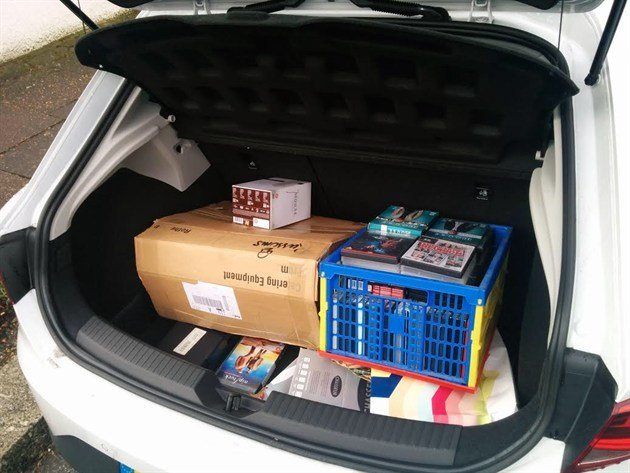
There's the same amount of boot space as in the five-door.
Now, care of improvements to safety equipment and quality, it’s much harder to get in and out of the back row of a car in a dignified manner – although on balance I think I’d rather have a safer car that’s a bit tricky to get into than a really unsafe one that's easy access. In the Leon's defence it's a problem with all modern three-doors.
Thankfully the Leon doesn’t fall into another common three-door car trap – the seats, once folded forward to let someone in, will return to their original position with one shove. Rather irritatingly many three door cars don’t have that function - the seats simply stop on their runners wherever you release them. It’s something that irritated me about my previous Hyundai i30.
To be fair it’s rare that I ever need to carry anyone in the back row, but many small families will pick a three door if their children are old enough to go without a car seat. For them, the Leon will be fine – my 14-year-old sister was quite content and had more than enough space.
So if you’re wondering about which will suit you the most, then it comes down to your usage. If you have a child or teenager who can fold themselves into the back row then the Leon SC is fine – it looks better than the five-door and it’s a bit cheaper. You won’t lose any boot space, so the only reason to pick the five-door is if you carry adult passengers a lot, or if you have a child seat to get in and out.
Are you not infotained?
The Leon has a comprehensive in car infotainment system with navigation, DAB radio and great connectivity - here's a more in depth look at how it works.
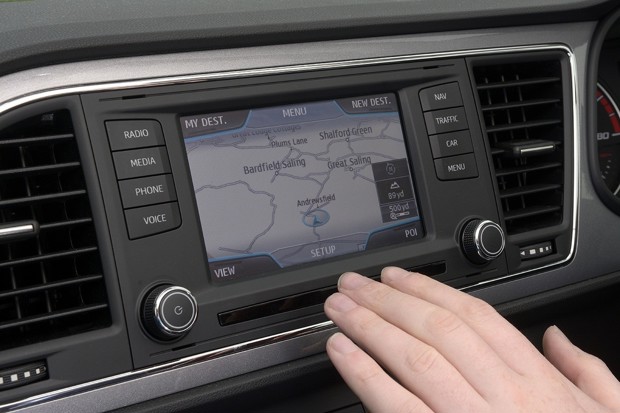
Date: 24 February 2014 | Current mileage: 3736 | Claimed economy: 54.3mpg | Actual economy: 46.4mpg
When we ordered our SEAT Leon we were lucky enough to qualify for a special offer from SEAT, which meant the technology pack was fitted for free. This is made up of full-LED headlights, DAB radio and a navigation system. It's a pretty enticing offer and the kit has really made our time with the Leon so far easier and more enjoyable.
The navigation system is a real highlight – it’s extremely easy to use and configure plus the display is very user-friendly. Other car manufacturers could certainly learn a thing or two from SEAT. When programming a destination you’re presented with three, clearly colour coded routes - one short, one quick and one efficient.
The system keeps its eyes (or microchips) on the traffic conditions and recalculates if things get busy – which can be a bit of a pain – but besides that it’s one of the nicest built-in nav systems I’ve ever used. Its interface is part of a touchscreen system, which isn’t all that large compared to some cars. It is, however, very cleverly put together.
It has a sensor underneath it that detects when a hand is nearby and will then show the touchscreen buttons. When your hand is taken away the buttons pop off the edges of the screen, maximising the use of space – the touchscreen interface is only there when you need it, otherwise the screen is dedicated to displaying the map or radio with no clutter.
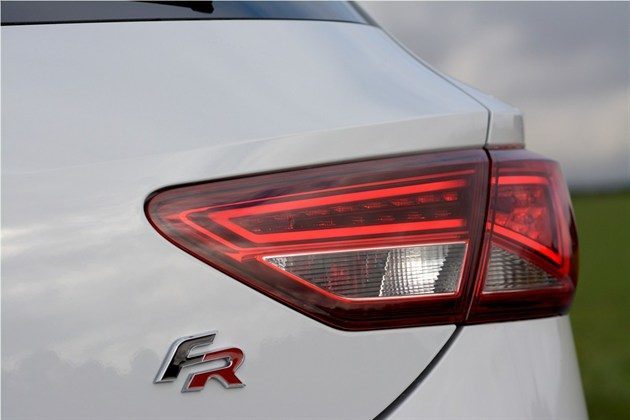
LED lighting features both front and rear
The technology pack also bundles in DAB radio, which is fantastic. I tend to make fairly short trips around London and that means it's not worth connecting up an iPod for the sake of 15 minutes or half an hour – the radio is far more convenient. With DAB, the audio quality is excellent and there’s a lot more to choose from, so I consider it more or less essential.
Many car makers offer DAB now, but few make the interface for selecting a station so easy – usually you have to trawl through regions before you find your local area, then find a station that works. With the Leon, everything that's available is displayed and everything that doesn’t is filtered out. It makes tuning in painless.
The last extra featured in the technology pack is the LED-headlights pack, which is very impressive indeed for a car of this size. Full-LED headlights do appear on bigger, more luxurious cars, but no other family hatchback uses them. They’re great to look at and they’re beautifully clear, with bright, pure white light.
I don’t rely on headlights as much as many people – most of the places I drive are lit by street lamps – but on the few occasions I’ve driven on unlit country roads the LED system has been very bright and very clear, although it’s not exactly a revolution in terms of brightness and clarity. It is, however, likely to last for a long time – LEDs shouldn’t wear out like traditional light bulbs.
The technology pack offer won’t last forever, however the gear it offers is so useful that I’ve found it almost essential – so if you’re buying a new Leon and the technology pack offer is over, the navigation system is excellent, as is the DAB radio. Full-LED headlights, however, might not be worth the extra. They certainly make the car look terrific, but they aren’t a radical improvement over traditional lights.
Out of semi-retirement
After a few weeks spent driving other cars I take the SEAT on a long drive to stretch its legs.
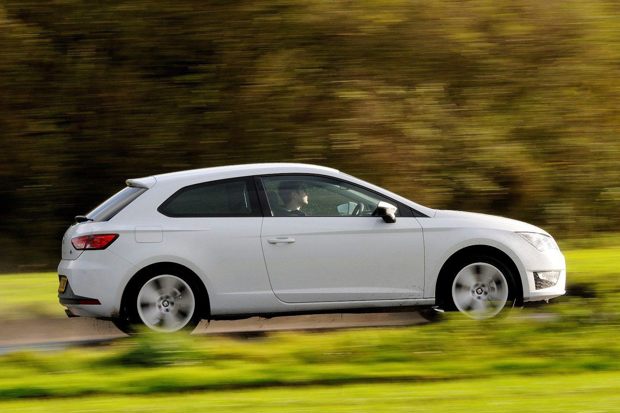
Date: 21 March 2014 | Current mileage: 3932 | Claimed economy: 54.3mpg | Actual economy: 53.2mpg
London is a funny place – every street is lined with cars, but many of them spend months at a time standing still and, for a couple of weeks recently, my SEAT joined them. I had very few journeys to make and those that were necessary were undertaken in other cars, which I was road testing.
It’s never a good idea to leave a car standing for a long period of time – it’s bad for the brakes and the battery – but when I brought the Leon out of semi-retirement it fired up easily and drove perfectly. That was a nice surprised, but the fuel tank was almost empty.
Normally I fill up wherever is easiest, typically with regular petrol – but for a bit of an experiment I tried Shell V-Power, which cost a few more pence-per-litre but is supposed to clean the engine and improve economy. After that, it was off to Brighton for a weekend of wasting money in the 2p falls.
On the motorway down, the Leon managed better fuel economy than I’d ever seen before. cruising at a steady 70mph I saw an average of 52.3mpg, which is very, very close to the official figure. Admittedly the conditions were perfect, which was novel given the relentless rain we’ve had the past few months, but I can attribute at least some of those extra few miles-per-gallon to the V-Power fuel.
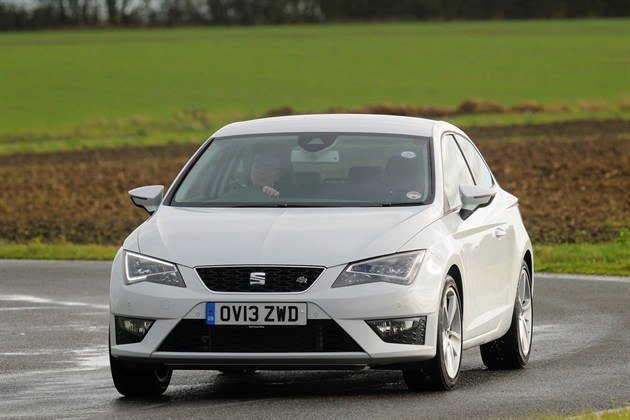
The Leon is a pleasure to come back to after time in other cars
Indeed, at a few points along the trip the average went up to more than 55mpg, beating the official fuel economy figure. Granted, that was only for a few miles and it quickly dropped back down when we reached any traffic. There were a few 50mph zones, too, which always help improve the average fuel economy.
At least they were painless with cruise control – the trip to Brighton was relaxed and easy, and a great way to reacquaint myself with the Leon, which is always a pleasure to come back to after time in another car.
You might now expect a fancy photograph of the car illuminated by the pier lights, but I’m from Yorkshire. So I saved myself a few bob by parking for free in the north of town and getting a bus to the seafront instead. The hotel was a bargain too...
One thing I didn’t do when getting back into the Leon was give it a wash. Its white paint has a thick layer of London grime on it, which is a real shame because it looks great when it’s polished up – so the next task is to get it back to its best, almost as if to apologise for the neglect!
We wave goodbye to the Leon
It's time to say goodbye to our SEAT Leon. Its replacement has some very big boots to fill.
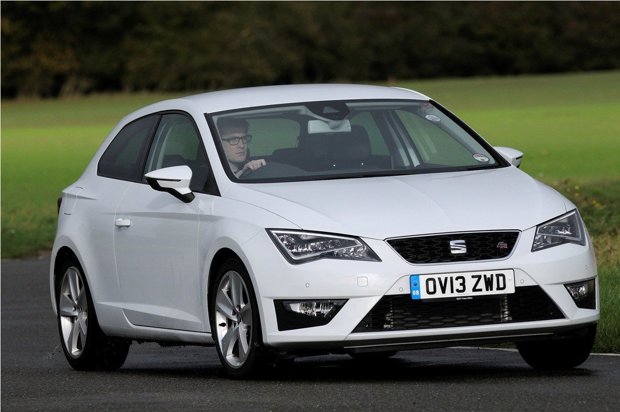
Date: 16 April 2014 | Current mileage: 4132 | Claimed economy: 54.3mpg | Actual economy: 48.6mpg
After 4000 miles, approximately 83 gallons of fuel and one bottle of wiper fluid it’s time to say goodbye to our excellent SEAT Leon FR. It has been up and down the UK, but it’s spent a lot more of its time in London. So what's the final verdict on the sporty SEAT?
Well it’s easy to drive in nose-to-tail London traffic, plus it’s simple to park thanks to an impressive parking sensor system. However it’s also a surprisingly swift performer. With 140PS from a 1.4-litre petrol engine it’s capable of raising a smile – 0-62mph takes an almost hot-hatch quick 8.1 seconds thanks to the fact that small engine is turbocharged.
The handling is neat and precise, so twisting roads are great fun, with the enjoyment enhahced by a purposeful engine note at higher revs. Yet, on top of that, it’s quiet and refined when you’re not in the mood for fun, plus it’s relaxed on the motorway thanks to cruise control and lane keep assist.
Unfortunately the lane assist system was the only thing that went wrong in our time with the car. After a few weeks it stopped ‘seeing’ the lanes in the motorway and displayed an error message. It needed to be returned to SEAT, but it turned out to be a loose screw that caused the sensor to aim in the wrong direction. It was back promptly and hasn’t gone wrong since.
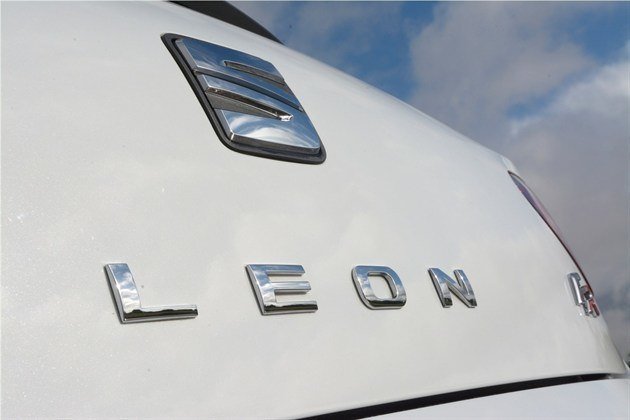
Being an FR our Leon has sports suspension, which you might think would make it overly firm and uncomfortable. Thankfully that’s not the case – it’s excellent through corners. Body roll is kept at bay and there is plenty of grip, but there’s enough compliance to keep the car comfortable over rough roads, speed bumps and potholes.
The FR trim also adds some nice interior details like a flat bottomed steering wheel and red stitching, plus sportier exterior styling. Another nice extra offered with the Leon when we ordered it was a free technology pack, which includes full-LED lights. Along with the optional white paint they make for a great-looking car.
Also included in the pack is a navigation system, which is extremely user-friendly and works well. Very occasionally it redirects you unnecessarily to avoid a phantom traffic jam, but otherwise it’s excellent, with clear directions and an accurate estimated ETA.
Fuel economy over the past six months has been reasonable. The official figure is 54.3mpg, which is impressive for a 140PS petrol engine. It hasn't quite matched that in everyday driving, but with a light right foot it's easy to come close. On average our car delivered just shy of 50mpg. Pretty good going.
The Leon has some very close relatives in the Volkswagen Group family – namely the Audi A3, Skoda Octavia and Volkswagen Golf. Each has its merits, but when you consider the Leon’s enticing price and sharp styling it comes out as a clear winner – for me at least.
Of the numerous cars I’ve run for the Our Cars section the Leon has been the most impressive – it offers the best of all worlds. It has strong performance, neat handling, practicality, plus style and quality. The faults that are present are minor quibbles rather than serious problems. It’s going to be sad to say goodbye to such a good all round car and its replacement has some very big boots to fill.
